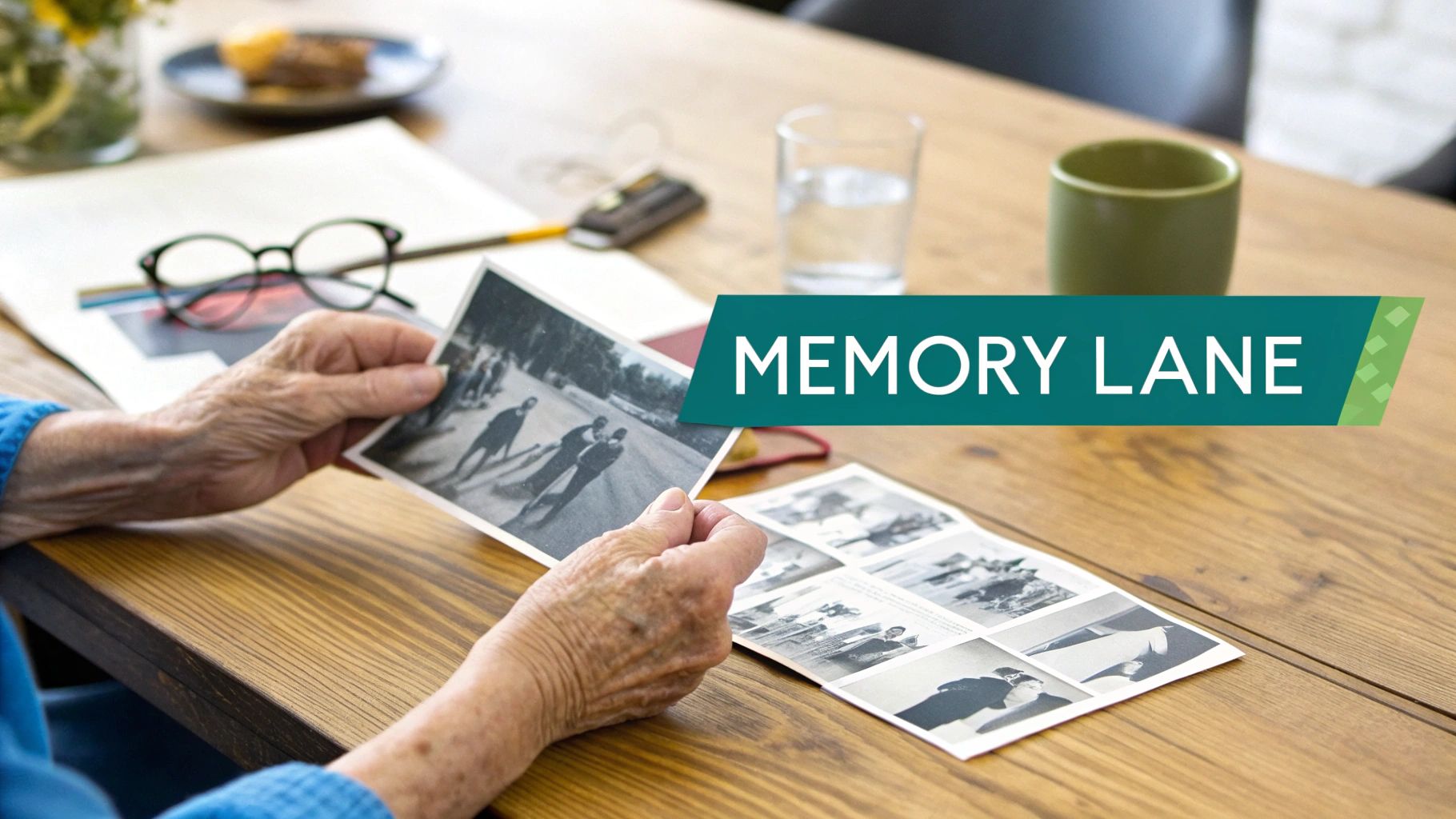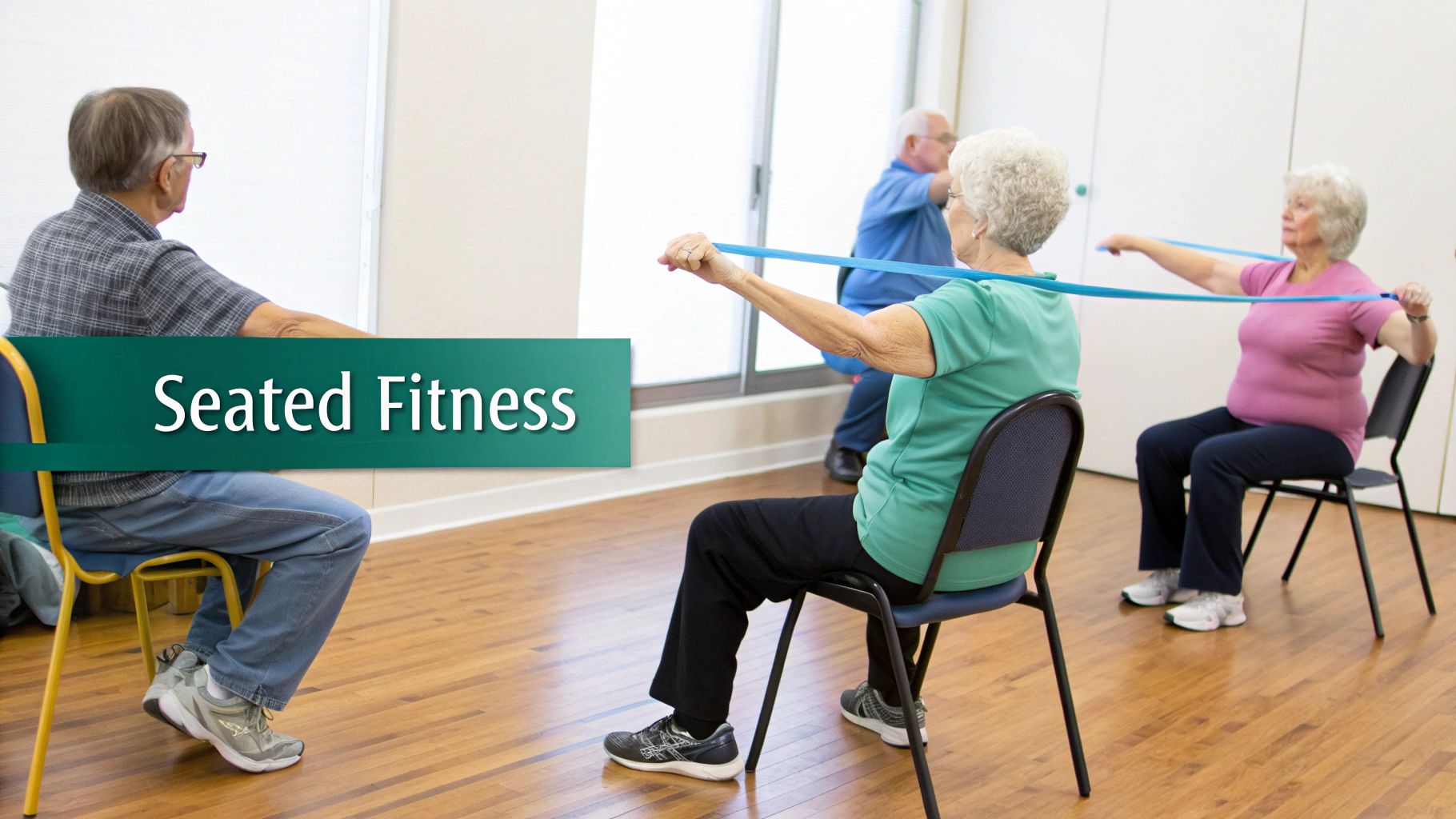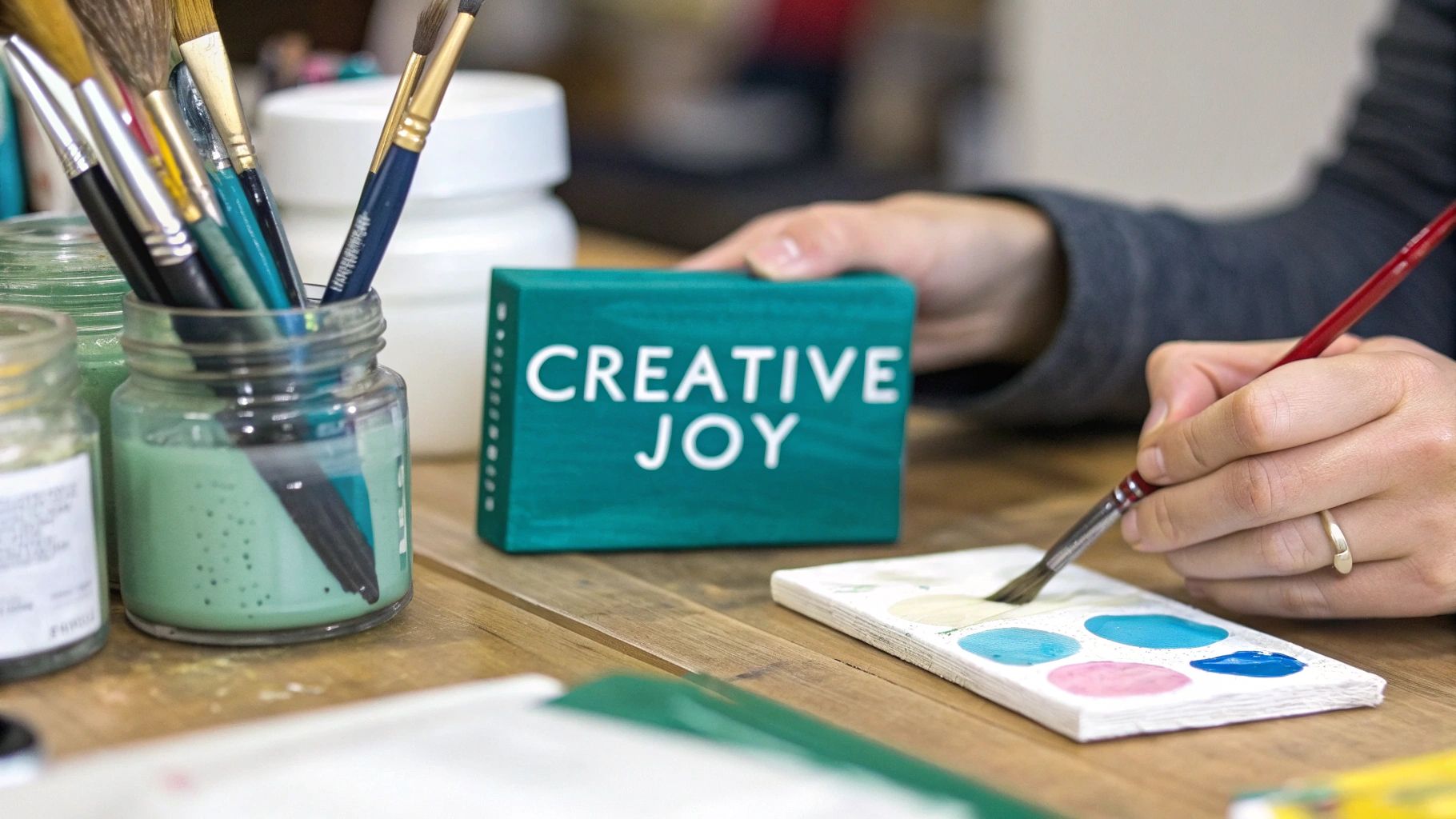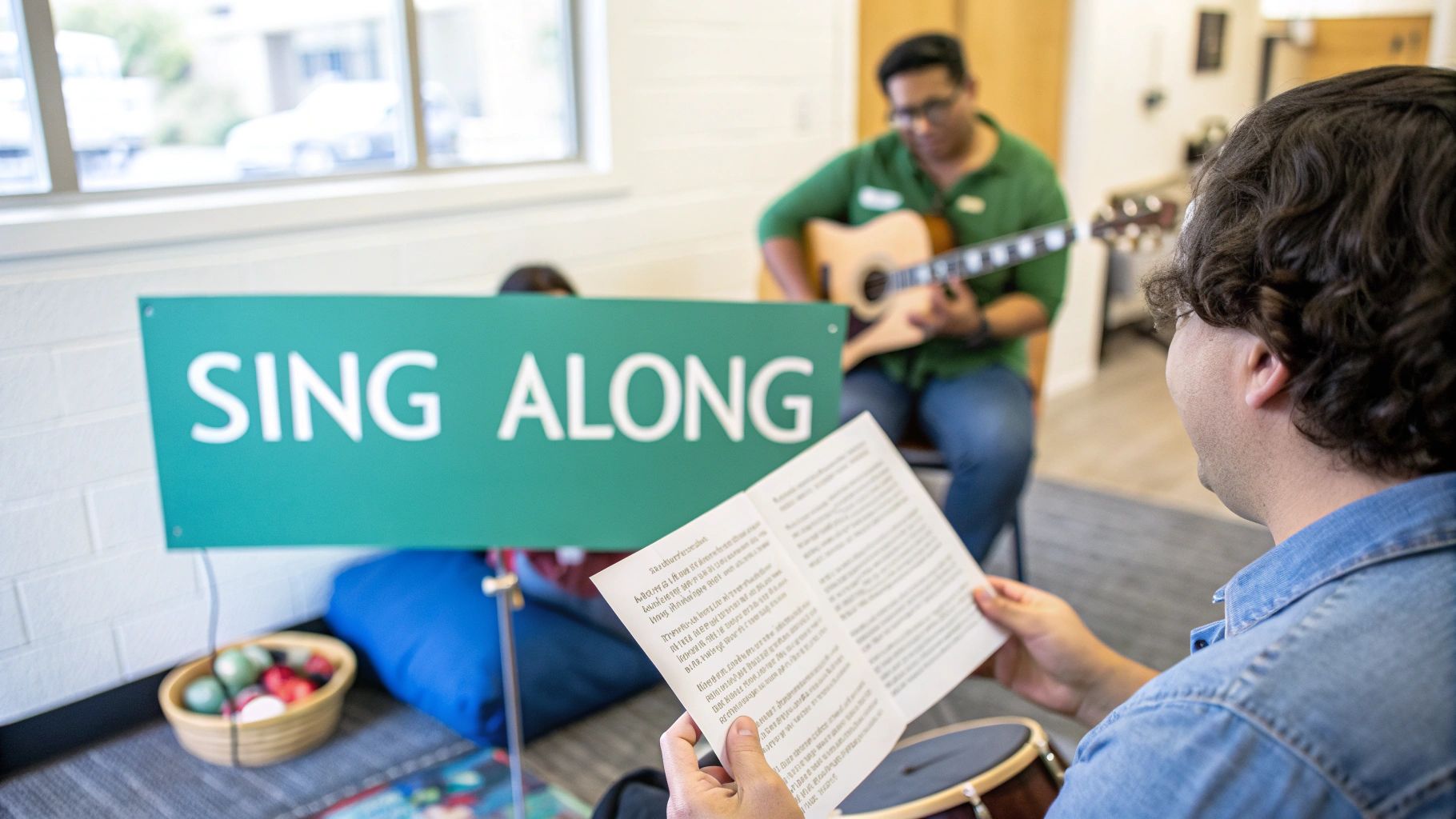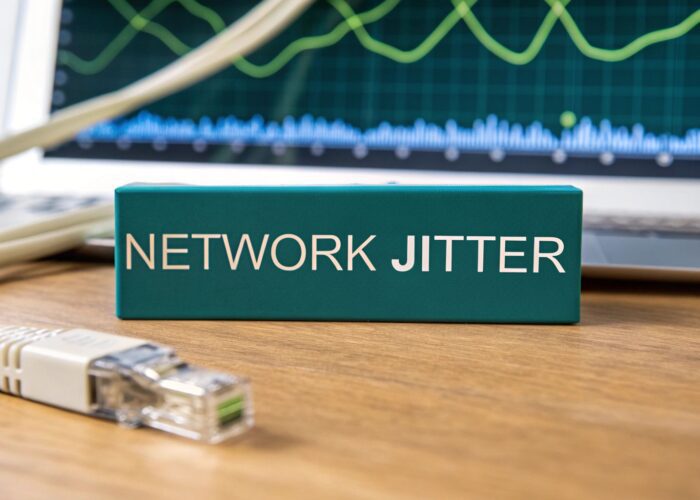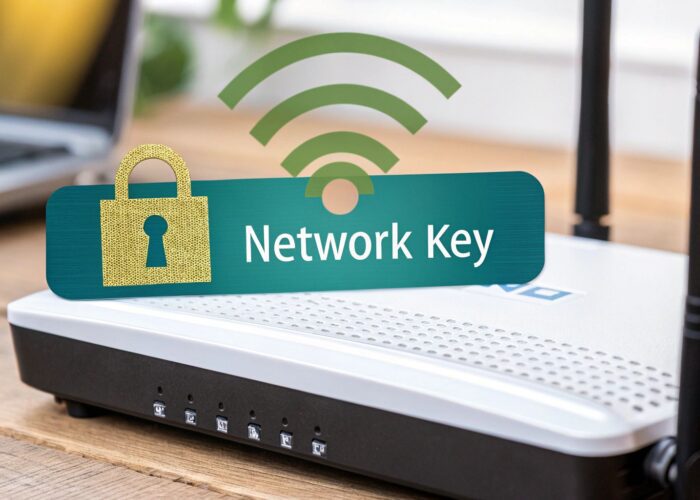Welcome! If you're looking for fresh, impactful activities for assisted living facilities, you have come to the right place. It's all about moving beyond the expected to foster a vibrant, engaged community where residents can truly thrive. We're talking about creating daily moments of joy, connection, and purpose that enrich lives on every level. The heart of a great program is offering a rich variety of options, including different types of therapeutic activities for mental health, to boost residents' overall well-being.
In our connected age, technology is a huge part of what keeps us all linked together. Just as a secure and simple Wi-Fi network is essential for residents to stay in touch with family, the activities we plan are crucial for them to connect with each other. Imagine a reliable guest Wi-Fi network, managed with Cisco or Meraki solutions, that lets families seamlessly join video calls during virtual events. This same principle of easy, secure access should apply to our activities, making participation a breeze for everyone.
This guide is your go-to collection of ten engaging and practical activity ideas. We’ll offer actionable insights and specific tips to help you create an environment where joining in is both effortless and deeply rewarding. Let's dive into some fresh perspectives!
1. Reminiscence Therapy and Memory Care Programs
Reminiscence therapy is a wonderful, evidence-based approach that uses sensory cues from a person's past to spark memories and get conversations flowing. This activity is especially powerful for residents with dementia or cognitive decline, as it helps them reconnect with their personal history, reinforcing their identity and boosting emotional well-being. It's easily one of the most impactful activities for assisted living facilities because it turns simple chats into truly therapeutic experiences.
This method is about more than just remembering; it's about validating a person's life and experiences, which can significantly ease agitation and build social connections among residents.
How to Implement Reminiscence Therapy
A great program starts with creating a safe and encouraging atmosphere where residents feel comfortable sharing.
- Memory Boxes: Team up with families to create personalized boxes filled with meaningful items like old photos, letters, trinkets, or fabric swatches. These tactile objects are fantastic memory triggers.
- Themed Discussions: Organize group sessions around specific themes, like "First Cars," "Favorite Holidays," or "Music from Our Youth." Playing vintage music or showing classic film clips can really bring the experience to life.
- Digital Tools: Use modern tech to create digital slideshows of old family photos or virtual tours of residents' hometowns using Google Maps. These engaging visuals are easy to manage and display on a secure Wi-Fi network. For facilities looking to up their digital game, exploring senior living technology solutions can provide great insights into managing resident and guest network access securely.
Key Insight: Remember, the goal isn't to test memory but to spark positive emotions and connections. Focus on the feelings the memories bring up, not whether every detail is perfect. This approach creates a supportive and validating vibe for everyone.
2. Chair-Based Exercise and Gentle Fitness Classes
Staying active is key to good health at any age, and chair-based exercise programs make fitness accessible to everyone. These classes are smartly designed to improve strength, flexibility, and heart health while participants are seated or using a chair for support. This makes them one of the most inclusive and essential activities for assisted living facilities, especially for residents with limited mobility, arthritis, or balance issues.
By adapting traditional exercises, these programs help promote independence, lower the risk of falls, and boost residents' confidence—all within a safe and friendly group setting.
How to Implement Gentle Fitness Classes
An engaging and effective chair exercise program is all about consistency, variety, and a focus on safety.
- Diverse Class Offerings: Keep things fresh by introducing a variety of styles. Think seated yoga for flexibility, adapted Tai Chi for balance, or resistance band workouts for strength. You can even stream guided classes from platforms like YouTube for professional instruction and endless options.
- Use Appropriate Equipment: Simple tools can make a big difference. To support these activities, facilities can look into using specialized gear like low impact exercise equipment for seniors, including lightweight dumbbells, resistance bands, and small exercise balls.
- Create a Motivating Atmosphere: Put on some upbeat, age-appropriate music to lift everyone's energy and spirits. Make sure staff are on hand to offer assistance, encouragement, and ensure proper form. Scheduling classes two or three times a week helps build a routine and deliver real health benefits.
Key Insight: The focus should always be on participation and personal progress, not competition. Celebrate the small wins, like better range of motion or increased stamina, to foster a positive and encouraging environment that keeps residents excited about their fitness journey.
3. Art and Craft Projects
Creative outlets like painting, pottery, and quilting are fantastic for self-expression and keeping minds sharp. These activities are incredibly adaptable to various physical and cognitive abilities, making them a cornerstone of any good program. Getting artsy has therapeutic perks, like improving fine motor skills, reducing anxiety, and giving residents a wonderful sense of accomplishment, which is why they are essential activities for assisted living facilities.
These projects let residents create something tangible and beautiful, which is a great boost for self-esteem and a meaningful way to spend time. Plus, the social side of a group craft session helps build community and combat loneliness.
How to Implement Art and Craft Projects
A successful art program is all about being inclusive, sparking creativity, and celebrating the final product, no matter the skill level.
- Offer Diverse Options: Provide a variety of projects, from weekly painting classes and seasonal decoration crafting to collaborative community quilts. This ensures there's something to pique everyone's interest.
- Use Adaptive Tools: Make crafting accessible for everyone by supplying tools like oversized brushes, spring-loaded scissors, or ergonomic pencil grips for residents with arthritis or limited dexterity.
- Showcase Resident Art: Proudly display finished artwork in hallways, common areas, or a dedicated gallery space. This not only celebrates the residents' achievements but also beautifies the facility. For a digital showcase, a robust Wi-Fi network managed by solutions from Cisco or Meraki ensures that high-res photos of the art can be easily shared on a secure Captive Portal for families to view.
Key Insight: Put the emphasis on the creative process, not a perfect result. The goal is to encourage self-expression, joy, and social fun, not to produce professional artists. This pressure-free approach makes everyone feel welcome and successful.
4. Garden and Horticultural Therapy
Horticultural therapy uses gardening and plant-based activities to boost both physical and mental well-being. This hands-on approach connects residents with nature, giving them a sense of purpose, gentle physical exercise, and satisfying results. As one of the most fulfilling activities for assisted living facilities, it lets seniors nurture living things, which can lift moods, reduce stress, and even improve cognitive function.
This activity is super adaptable, working for various mobility levels—from outdoor community gardens to indoor windowsill herb pots. It encourages social interaction, provides sensory stimulation, and can even yield fresh produce for the community kitchen.
How to Implement Garden and Horticultural Therapy
Creating a great gardening program means making it accessible, safe, and engaging for all.
- Accessible Garden Design: Build raised garden beds at waist height to eliminate bending and kneeling. Make sure pathways are wide enough for wheelchairs and walkers. Use lightweight tools with ergonomic handles to accommodate different strength levels.
- Start Small and Simple: Begin with easy-to-grow plants like herbs (mint, basil), cherry tomatoes, or marigolds. A successful first harvest builds residents' confidence. Windowsill herb gardens are a perfect starting point for individual units.
- Sensory and Group Activities: Include sensory plants with interesting textures, vibrant colors, and strong fragrances like lavender or rosemary. Organize group activities around planting, watering schedules, and harvesting, and cap it off with a cooking session using the garden's bounty. This teamwork promotes social bonding.
Key Insight: The journey is just as important as the destination. Focus on the daily joys of tending the garden—watering plants, watching them grow, and enjoying the fresh air—rather than just on a perfect harvest. This keeps the activity a low-pressure, therapeutic experience.
5. Music and Singing Programs
Music and singing programs tap into the deep connection between sound, memory, and emotion, making them a fantastic choice for engaging activities for assisted living facilities. These events can range from lively sing-alongs and music appreciation sessions to live performances. They are especially great for residents with cognitive decline, as musical memories often stick around long after others fade, providing a powerful way to connect and find joy.
This is more than just entertainment; it can reduce anxiety, stimulate the brain, and foster a strong sense of community as residents share a common, uplifting experience.
How to Implement Music and Singing Programs
A successful music program involves thoughtful planning and personalization to suit residents' diverse tastes and abilities.
- Curated Playlists and Sing-Alongs: Plan weekly sing-alongs using beloved songs from residents' younger years. Provide large-print lyric sheets and use high-quality speakers to stream curated playlists by decade or genre.
- Live Performances: Invite local musicians, school choirs, or community groups to perform. Scheduling and promoting these events is simpler with the right tech; for instance, Meraki digital signage feeds can display upcoming event schedules on screens throughout the facility.
- Interactive Music Groups: Organize simple rhythm or drum circles where residents can join in with easy-to-use instruments like tambourines or maracas. This encourages active participation and creative expression for all mobility levels.
Key Insight: The focus should be on participation and fun, not on performance or perfection. Music is a universal language that can transcend cognitive and physical barriers, creating shared moments of happiness for everyone.
6. Intergenerational Programs
Intergenerational programs create amazing bonds by connecting residents with younger generations, from elementary school kids to college students. These interactions help combat loneliness, give residents a renewed sense of purpose, and offer profound learning experiences for the youth. By bridging the age gap, these initiatives are some of the most rewarding activities for assisted living facilities, fostering empathy, respect, and a vibrant community spirit.
This synergy is a win-win. Residents love the energy and fresh perspectives of young visitors, while the younger folks gain wisdom and a deeper appreciation for the lives of their elders.
How to Implement Intergenerational Programs
Building a successful program requires careful planning to ensure activities are mutually enjoyable and meaningful for everyone involved.
- Structured Partnerships: Collaborate with local schools or youth groups. Arrange for elementary students to visit for story time, high schoolers to help with tech workshops, or college students to conduct oral history interviews.
- Creative Collaborations: Organize joint projects like a community garden, a holiday choir performance, or a pen pal exchange. These shared goals help build lasting relationships.
- Leverage Technology: Facilitate virtual visits or collaborative online projects. A reliable network using Cisco Meraki infrastructure ensures seamless video calls. Secure guest access through a Captive Portal allows visiting students and families to connect easily, just like how educational institutions are enhancing the student experience. Authentication Solutions can manage access for various visiting groups securely, keeping your network safe.
Key Insight: The key to a great intergenerational program is consistency. Regular, scheduled interactions allow genuine relationships to blossom over time, moving beyond one-off events to create a true sense of an extended family and community.
7. Recreational Games and Cognitive Activities
Recreational games and cognitive activities are the bedrock of a vibrant community, offering mental stimulation, social fun, and pure entertainment. From classic board games to modern digital challenges, these activities help maintain cognitive function, prevent boredom, and spark some friendly competition. This makes them one of the most versatile and enjoyable activities for assisted living facilities, perfect for a wide range of interests and abilities.
These activities aren't just about passing time; they are designed to support brain health, fine motor skills, and social bonds, directly contributing to a resident's quality of life.
How to Implement Recreational Games and Cognitive Activities
A winning game program is varied, accessible, and consistently scheduled to become a regular part of community life.
- Diverse Game Library: Stock common areas with a wide array of options, including large-print card decks, accessible board games like Scrabble or chess, jigsaw puzzles with different difficulty levels, and bingo sets.
- Scheduled Tournaments: Organize weekly or monthly tournaments for popular games like bridge, pinochle, or even Nintendo Wii bowling. This builds excitement and a fun sense of community achievement.
- Digital Gaming Stations: Set up dedicated stations with tablets or computers for residents to enjoy brain-training apps or social games. Managing access to these devices on a secure Wi-Fi network, powered by solutions from providers like Cisco Meraki, is vital for a safe and smooth user experience. Implementing a Captive Portal with simple Authentication Solutions ensures only residents and authorized guests can connect.
Key Insight: The main goal is engagement and fun, not just winning. Feel free to adapt the rules to suit different cognitive and physical abilities, making sure everyone feels included and can participate successfully. The social interaction is often the most valuable part of the game.
8. Pet Therapy and Animal-Assisted Activities
Pet therapy and animal-assisted activities involve bringing animals into the facility to provide comfort, companionship, and emotional support. This practice is scientifically proven to reduce stress, lower blood pressure, and fight feelings of loneliness and depression. For residents, especially those with cognitive decline, the unconditional affection from an animal can be incredibly calming, making it one of the most heartwarming activities for assisted living facilities.
These interactions foster a sense of purpose and joy, break up daily routines, and create memorable experiences that encourage social engagement among everyone.
How to Implement Pet Therapy
A successful program requires careful planning to ensure the safety and comfort of both the residents and the visiting animals.
- Certified Animal Visits: Partner with certified organizations to schedule regular visits from trained therapy dogs, cats, or even rabbits. These animals are screened for temperament and health, guaranteeing positive interactions.
- Resident Pet Programs: Think about adopting a facility cat that can roam common areas or setting up an aviary or aquarium. Involving residents in the daily care, like feeding the fish, provides a gentle sense of responsibility.
- Structured Interaction Sessions: Organize dedicated petting stations or one-on-one sessions for residents who may be less mobile. This ensures everyone who wants to participate gets the chance in a controlled and comfortable setting.
Key Insight: Consistency is key to building bonds. Schedule animal visits at regular times and, if you can, with the same animals. This predictability helps residents, particularly those with dementia, form meaningful connections and look forward to the visits.
9. Spiritual and Mindfulness Programs
Spiritual and mindfulness programs address the essential emotional and inner needs of residents, offering paths to peace, meaning, and connection. These activities can range from traditional religious services to secular mindfulness practices, providing comfort and reducing anxiety. Integrating these practices is a compassionate way to support holistic well-being, making them vital activities for assisted living facilities that care for the whole person.
These programs create a supportive space where residents can explore their beliefs, find solace, and connect with others on a deeper level, which is so important for mental and emotional health.
How to Implement Spiritual and Mindfulness Programs
Creating an inclusive and respectful program means planning thoughtfully and offering a variety of options to suit diverse beliefs and physical abilities.
- Offer Diverse Gatherings: Host a mix of activities, such as chaplain-led religious services for various faiths, non-denominational prayer groups, and weekly guided meditation circles focused on stress reduction.
- Introduce Gentle Movement: Organize gentle yoga or Tai Chi classes specifically adapted for seniors. These practices link mind and body, improving balance, flexibility, and mental clarity.
- Create Quiet Spaces: Designate a quiet room or a peaceful garden corner for personal reflection, prayer, or meditation. Ensuring this space has reliable Wi-Fi, managed through robust solutions compatible with Cisco Meraki systems, allows residents to securely access digital spiritual resources, like guided meditations or live-streamed services, on their personal devices.
Key Insight: The focus should be on providing comfort and connection, not on conversion or debate. Respecting each resident's individual spiritual journey is crucial for creating a truly supportive and peaceful environment for everyone.
10. Educational Lectures and Lifelong Learning Programs
Fostering intellectual curiosity is a cornerstone of a vibrant community, and lifelong learning programs are a perfect way to keep residents engaged and mentally sharp. These structured educational opportunities, from guest lectures to documentary screenings, provide a platform for continuous growth and social fun. This makes them one of the most intellectually stimulating activities for assisted living facilities, helping to maintain cognitive vitality and provide a real sense of purpose.
These programs transform the facility into a hub of discovery, where residents can explore new subjects, revisit old passions, and have meaningful discussions with their peers.
How to Implement Lifelong Learning Programs
A successful educational program involves curating content that resonates with residents' interests and providing the right environment for learning.
- Diverse Course Offerings: Survey residents to find out what they're curious about. Offer a variety of topics, like a guest historian discussing local events, monthly travel documentaries with a Q&A, or tech classes focused on using tablets and smartphones.
- Community Partnerships: Team up with local colleges, museums, or community organizations like public libraries to bring in expert speakers. Many public libraries are expanding beyond just books and are often eager to partner on community education.
- Optimized Learning Environment: Ensure a great experience with large screens and clear audio systems. A reliable Wi-Fi network, managed with a robust Captive Portal, is essential for streaming content or letting guest speakers connect their devices securely. This infrastructure supports both the educational delivery and resident connectivity.
Key Insight: The success of these programs lies in accessibility and engagement. Focus on creating an interactive, low-pressure atmosphere where questions are encouraged and discussion is valued over formal tests. This ensures learning remains a joyful and social experience.
Top 10 Assisted Living Activities Comparison
| Activity | 🔄 Implementation Complexity | ⚡ Resource Requirements | 📊 Expected Outcomes | 💡 Ideal Use Cases | ⭐ Key Advantages |
|---|---|---|---|---|---|
| Reminiscence Therapy and Memory Care Programs | Medium — needs trained facilitators and individualized prep | Low material cost; moderate staff time; family collaboration | Improved mood, reduced agitation, increased social engagement | Residents with dementia or memory loss; one‑on‑one or small groups | High personalization and evidence-backed emotional/cognitive benefits (⭐⭐⭐) |
| Chair-Based Exercise and Gentle Fitness Classes | Low — simple routines but instructor oversight recommended | Minimal equipment (chairs, bands); indoor space; instructor | Maintains strength, improves balance, lowers fall risk | Residents with limited mobility, arthritis, balance concerns | Safe, accessible way to preserve independence (⭐⭐) |
| Art and Craft Projects | Low — materials prep and cleanup; occasional assistance | Modest supplies; adaptive tools; display space | Enhances fine motor skills, reduces anxiety, boosts self-esteem | Creative expression, fine‑motor rehab, group art sessions | Tangible outcomes and highly adaptable to abilities (⭐⭐) |
| Garden and Horticultural Therapy | Medium — requires setup (beds), seasonal planning and upkeep | Outdoor/indoor space, tools, plants, maintenance staff/volunteers | Improves mood, light physical activity, sensory engagement, sense of purpose | Residents who enjoy nature; therapeutic/outdoor programs | Multi-sensory engagement and tangible yields (flowers/produce) (⭐⭐) |
| Music and Singing Programs | Low — simple playlists to structured therapy with credentialed therapists | Sound system, curated playlists or live musicians/music therapist | Strong mood lift, memory stimulation, reduced behavioral issues | Dementia care, group sing‑alongs, calming transitions | Highly accessible with strong evidence for dementia benefits (⭐⭐⭐) |
| Intergenerational Programs | Medium — coordination with schools/volunteers; safety protocols | Partnerships, volunteer management, scheduling, possible transport | Reduces isolation, increases sense of purpose, mutual benefits | Community-engagement initiatives; family/ school partnerships | Builds community ties and low-cost volunteer-driven impact (⭐⭐) |
| Recreational Games and Cognitive Activities | Low — easy to implement; staff facilitation improves inclusion | Game library, large‑print components, occasional consoles/tablets | Maintains cognition, encourages social interaction, entertainment | Regular social/activity schedules; cognitive stimulation sessions | Flexible, low-cost, scalable to cognitive levels (⭐⭐) |
| Pet Therapy and Animal-Assisted Activities | Medium — requires certified animals, handlers, safety protocols | Trained animals/handlers, vet care, insurance, screening | Lowers stress and blood pressure, increases mood and social engagement | Companionship-focused care; dementia and emotional-support programs | Strong physiological and emotional effects; fosters companionship (⭐⭐⭐) |
| Spiritual and Mindfulness Programs | Low — needs trained facilitators and cultural sensitivity | Quiet spaces, facilitators/chaplains, optional materials | Reduces anxiety/stress, improves emotional regulation and sleep | Residents seeking spiritual support, meditation, gentle movement | Low-cost, inclusive practices that enhance wellbeing (⭐⭐) |
| Educational Lectures and Lifelong Learning Programs | Medium — speaker recruitment, AV setup and scheduling | Guest speakers, AV equipment, printed materials, community partners | Sustains cognitive engagement, fosters curiosity and discussion | Intellectually curious residents; book clubs, documentary screenings | Stimulates intellect and community partnerships; varied topics (⭐⭐) |
Building a Connected and Thriving Community
Creating a vibrant, engaging environment in an assisted living facility is about so much more than just scheduling events. As we've seen, the most effective activities for assisted living facilities are those that nurture the whole person—addressing their physical, mental, emotional, and social well-being. From the reflective power of reminiscence therapy to the gentle movements of chair yoga and the creative joy of art projects, each activity is a vital thread in the fabric of a connected community. The goal isn't just to fill time; it's to create meaningful moments, foster genuine relationships, and empower residents with a sense of purpose and belonging.
The true success of any activities program lies in its adaptability and its ability to offer real choice. It's so important to recognize that residents have diverse interests, histories, and abilities. A program that seamlessly blends horticultural therapy for the nature lover, lifelong learning lectures for the intellectually curious, and pet therapy for the animal enthusiast is one that honors the individuality of each person. This person-centered approach transforms a simple schedule into a dynamic, thriving ecosystem of engagement.
The Technological Backbone of Modern Engagement
In today's digital world, a crucial and often overlooked part of community building is a solid tech infrastructure. Just as a BYOD Corporate office manages device policies or an Education campus provides seamless access for students, a modern senior living facility must provide reliable and secure connectivity. This is where a powerful network, powered by hardware from industry leaders like Cisco Meraki, becomes an essential tool for enhancing resident life.
A strong Wi-Fi network is the foundation that supports countless modern activities. It lets residents easily video call family, stream their favorite music, or join online educational courses. But providing access has to be balanced with security and ease of use. This is where advanced Authentication Solutions and Captive Portals come in. Using a system that supports IPSK (Identity Pre-Shared Key) or EasyPSK, you can give each resident and guest a unique, secure key to access the network. This eliminates the security risks of a shared password while staying incredibly simple for residents to use—removing tech friction and encouraging them to get online. A well-designed captive portal can welcome visitors, share info about daily activities, and make connecting a breeze, turning the facility’s Wi-Fi into a powerful tool for communication and engagement, much like in the Retail sector.
By thoughtfully integrating a diverse range of activities for assisted living facilities with a secure, user-friendly tech framework, you create an environment where residents are empowered, connected, and truly able to thrive.
Ready to enhance resident and guest connectivity with a secure, easy-to-use Wi-Fi authentication solution? Discover how Splash Access can integrate seamlessly with your Cisco Meraki network to create a powerful and welcoming digital experience for your community. Visit Splash Access to learn more and schedule a demo today.
